Generation Z is known for challenging the norms set by previous generations. Their preferences, communication styles, and even their sense of humor can often feel completely foreign to older generations. While we don’t need to adopt every new habit they bring into the world, it helps to understand their mindset a little better. This isn’t just about keeping up with trends—it’s about bridging a communication gap that’s becoming more noticeable by the day.

In this piece, we’ll explore a surprisingly controversial topic: the thumbs-up emoji. It might seem harmless to most people, even polite. But for some members of Gen Z, this simple gesture carries a whole different meaning—one that might surprise you.
Let’s rewind for a moment. First, Baby Boomers scratched their heads at Gen X. Then Gen X didn’t quite get Millennials. Now, the spotlight is on Gen Z, and everyone else is struggling to keep up. The youngest generation entering adulthood brings its own set of behaviors and unspoken rules—especially when it comes to digital communication. And the thumbs-up emoji? Well, it turns out that it’s become a subtle battleground for generational miscommunication.
To many older adults, the thumbs-up emoji is a go-to response. It’s quick, easy, and universal. Someone sends a message? You send a thumbs-up. Simple, right? Apparently not. A growing number of Gen Zers say they interpret the emoji as cold, dismissive, or even passive-aggressive. What was once seen as a friendly or affirmative gesture is now being questioned—and in some cases, completely avoided.
One Gen Z worker shared their personal experience after joining a professional job that used Microsoft Teams for internal communication. The platform offers a small selection of emojis to react to messages. Among them, the thumbs-up is one of the most commonly used. “Everyone at work uses the thumbs-up emoji all the time,” they explained. “But I don’t use it much. I’d rather heart a message or reply directly with something like ‘Thanks!’ or ‘Great!’ Even if it’s short, I feel it adds a bit more warmth.”
They continued, “I know it’s normal to react with a thumbs-up, but something about it just feels weird. It doesn’t sit right with me. Does anyone else feel this way?”
As it turns out, this person is not alone. A 24-year-old responded to the post and said, “For a lot of younger people, the thumbs-up emoji feels passive-aggressive. Like you’re brushing someone off or ending the conversation without really engaging.”
Another user chimed in with an observation: “It probably feels unsettling because it’s so impersonal. Just from your post, you seem like someone who values genuine, more thoughtful communication. Maybe the thumbs-up feels too robotic, like a conversation ender.”
It’s a subtle but meaningful difference. And it’s not just about emojis—it reflects how younger generations approach workplace culture, friendships, and everyday conversations. They place a higher value on emotional nuance and sincerity, even in something as small as a digital reaction. Gen Z, having grown up with smartphones and social media, has a very specific understanding of how digital communication shapes relationships. They pick up on tone through emojis, punctuation, and even response timing. So, to them, a thumbs-up emoji might come off as distant or even sarcastic, depending on the context.
Of course, not every Gen Zer agrees. There are plenty who still use the thumbs-up with no second thought. But the fact that so many do feel strongly about it shows how digital language is evolving. What was once a safe and universally positive emoji is now up for debate.
This shift isn’t meant to confuse or criticize older generations. It’s more of a reminder that language, including digital language, is always changing. Emojis are part of our modern vocabulary, and like words, their meanings can shift depending on who’s using them and how. Think about how the word “literally” has come to mean both “literally” and “figuratively.” Or how phrases like “OK Boomer” or “slay” have entered common conversation in completely new ways. Emojis are no different.
So, where does this leave the humble thumbs-up emoji? Should you stop using it entirely? Not necessarily. But it might be worth considering your audience. In a group chat with your friends or family, the emoji might still be received warmly. But in a conversation with younger coworkers or clients, maybe try a short reply instead. Something like “Sounds good!” or “Got it!” might convey a more positive and engaged tone.
At the end of the day, it’s not about policing emoji usage. It’s about being mindful of how our communication is received. As technology continues to shape the way we interact, paying attention to these little details can go a long way in building stronger, more respectful relationships—especially across generations.
What do you think about this? Has a thumbs-up emoji ever rubbed you the wrong way? Or do you still see it as a helpful, friendly shortcut? Leave a comment and let us know your take. Conversations like these are important because they remind us that even the smallest symbols—like an emoji—can have big impacts when it comes to how we relate to one another.
And if you found this article interesting, share it with someone who might enjoy it too. Sometimes, the smallest things spark the biggest conversations. Whether it’s a thumbs-up emoji or a heart reaction, every little digital cue matters more than we think.





